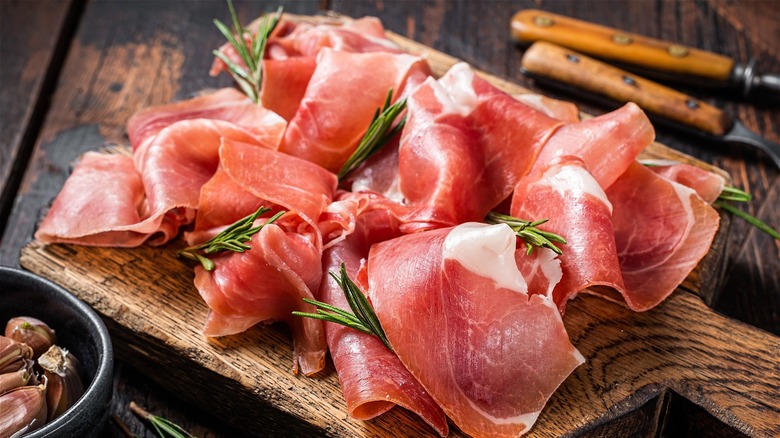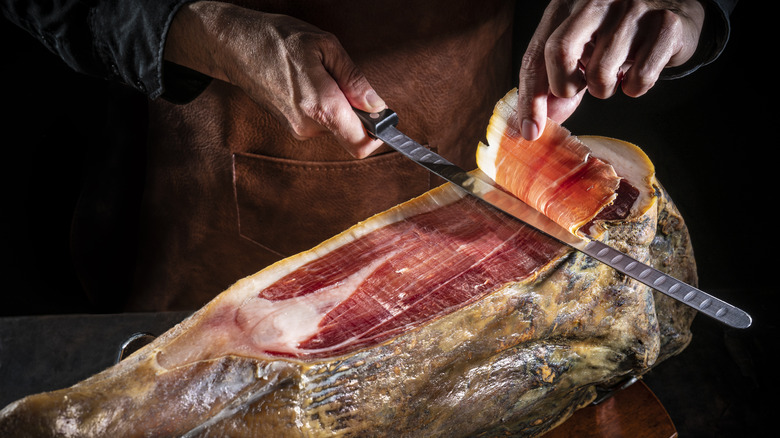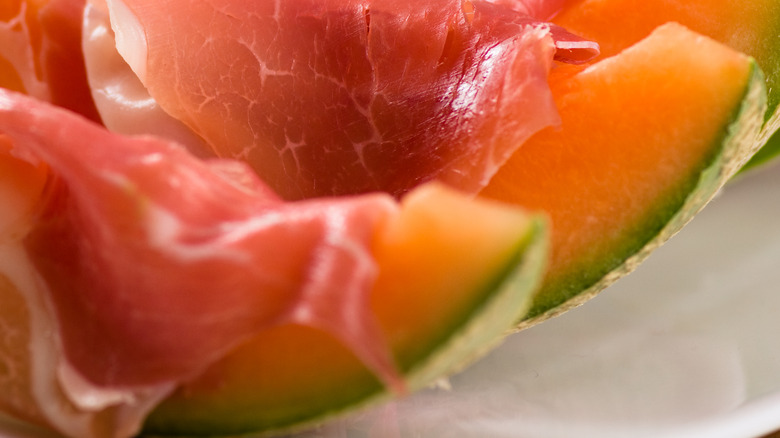The Overlooked Difference Between Prosciutto And Serrano Ham
Prosciutto and serrano ham are clearly gifts from the gods: How else do you explain meats that improve the quality of a charcuterie board so effortlessly? It's easy to assume the two cured meats are pretty much the same thing, one being Italian and the other Spanish — a mere accident of birth. After all, they even start with the same pig breeds (typically Duroc or Landrace).
But ask any Spaniard or Italian worth their salt(ed cured meat), and they'll say it isn't so. The differences go deeper than that, and many Mediterraneans are happy to explain the difference, especially if it means they can justify and defend their region's gastronomical superiority. Serrano and prosciutto hams (especially prosciutto from Parma) have become symbols of national culinary pride for both Spain and Italy.
There are some slight differences in feed: All the pigs are given grain-based feed, but the prosciutto-producing pigs consume more corn and also enjoy the leftover whey from the production of Parmigiano-Reggiano cheese. The differences are minor but do make their way into the respective meats' flavor: Prosciutto is lighter and more delicate, while serrano is more robust and even a bit gamey (though not dramatically so like the acorn-fed Iberico ham). The key differences come down to the way the meats are cured and aged which further differentiate the overall taste and mouthfeel of the two types of meat.
Prosciutto and serrano ham start out the same
Both prosciutto and jamón serrano are salted and kept initially in a cool environment to start the process. The salt is then rinsed off and the initial curing phase begins, after which the hams are left to dry out completely. Prosciutto is more lightly salted, however, and kept in a humid space for longer than jamón serrano. It's also generally left to dry for less time (about a year).
Serrano gets the "dryer" treatment: literally. After being heavily salted initially, the salt is washed off and the meat is left to rest and cure. But the meat cures in a much drier environment than prosciutto's: Serrano hams are kept in secaderos, or drying sheds, for 12 to 18 months. Those secaderos are traditionally located up on dry mountain ranges in northern Spain, hence the ham's name (serrano means "coming from the mountains").
Before its final curing phase, prosciutto is covered strategically with salted lard to keep it from drying out, imparting an additional layer of fat and flavor, while jamón serrano's flavor comes uniquely from the meat itself, making it more concentrated but also less creamy in texture.
Color, texture, and flavor differenes
Not surprisingly, the different curing methods result in significant texture differences: Prosciutto is more tender, while serrano ham is denser and drier. The tighter turnaround time from slaughter to sale for prosciutto pigs makes the meat less expensive and the ham better suited to food where a softer consistency is desirable (like, say, wrapping a melon). Serrano's longer aging process means its flavor is a bit richer and saltier, ideal for dishes where texture is less important than the flavor impact. There are differences in quality for both prosciutto and serrano ham. The best-known prosciutto is Prosciutto di Parma, whose production is heavily regulated but with lesser options available. Jamón serrano has gradations, many of which are based on the time the meat has been allowed to age and acquire greater depth.
Once you know what you're looking for, you don't need to be an expert to spot the difference, since prosciutto's softer slices and lighter pink color usually distinguish it from its darker, dryer, saltier counterpart. While they have their similarities, prosciutto and serrano ham are not the same thing. But despite their differences, you can still use them in lots of the same ways, and, frankly, it's hard to go wrong when it comes to ham this good.


